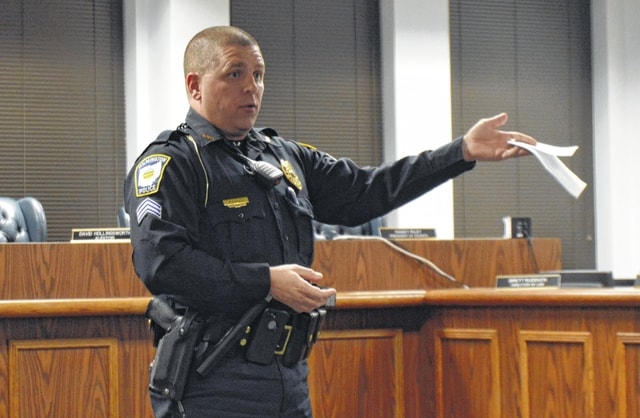
WILMINGTON — In a time when officers are “under a microscope,” according to Wilmington Police Chief Duane Weyand, city police used force 26 times in 2015.
That figure equates to force used in about 2 percent of all physical arrests, he said. Use of force reports kept and reviewed by the department show that a firearm was used once — when an officer was struck by a car in March 2015.
“Our philosophy is to follow the policy and the law first,” Weyand wrote. “Second, treat people like you want to be treated. … We don’t look for reasons to use any force. We find ourselves thrusted into terrible situations.”
Of the 26 reports, five said the force used was “red dot compliance,” where an officer points a Taser at someone who, upon seeing the red dot, complies with the officer’s request.
Types of force used include the use of a Taser, the use of batons, balance displacement and takedowns.
Sgt. Neil Rager told a Wilmington Police Department citizens’ advisory committee that use of force policies begin with hiring good officers. From there, he said, it’s about assessing the situation, using distance to help assess the scene and talking to a person.
Rager said getting people to talk can have a calming effect, and the sound itself can create a witness pool.
If talking to someone fails, Rager said the officer then has to decide how to handle the situation, which can include arresting someone, de-escalating the situation or even walking away if there’s no urgency.
“If I have the option, I can leave, let you calm down, file charges and come back,” Rager said.
According to Rager, talking, asking questions, giving people options and confirming with a suspect when he or she refuses to comply is often enough to begin defusing many situations.
He shared one of his own examples, where he asked someone to leave the hospital and answer some questions.
Rager said that person refused his request, so Rager gave the man the option of leaving of his own volition or with police making him leave. Eventually, Rager said, the man chose to leave.
Rager said distance also helps to assess whether someone’s conduct may be influenced by his or her mental health rather than violent tendencies. An officer can use time, distance and conversation to calm that person.
“A win is to control somebody so nobody is getting upset, nobody’s yelling and nobody’s getting hurt,” Rager said. “The low number of use of force (reports), I’m very proud of that.”
Rager also said that whenever someone is injured, complains about being injured or appears to be injured, it’s important for officers to call for medical assistance.
When he reviews the use of force reports, Rager said he considers an officer’s actions leading up to the use of force and even requires the officers to draw what happened.
“If you can’t explain to me why it’s reasonable, then I can’t explain to the chief why it’s reasonable and he can’t explain to the community why it’s reasonable,” Rager said.
Weyand wrote that officers undergo more than 2,000 hours of training, some of which includes how and when to use force.
WPD Sergeants Ron Cravens and Robert Martin train the officers on the range and on policies concerning the use of deadly force.
“We also had the shooting simulator at our safety center where officers were engaged in shoot/don’t shoot situations where they had to control a rapidly evolving situation with the right amount of force associated with the incident,” Weyand wrote.
Rager covers physical use of force policies and scenarios.
“Officers are subjected to physical scenarios where they are tasked with using force or no force,” during the training, Weyand wrote. “Sgt. Rager covers the foundation of why we can use force as well as how to properly use it. He starts with the bare minimum of force, which is an officer’s presence, and builds from there.”
Finally, Sgt. Ron Fithen covers the use of and policies concerning Tasers, where officers undergo scenarios and must decide if using a Taser is appropriate.
“When you examine the training component of use of force with the Wilmington Police Department you are looking at over 90 years of experience,” Weyand wrote. “This is essential to pass on the knowledge associated with making the right decisions. These are officers who have been involved in some of the most serious situations WPD has seen. The time and energy spent into making the P.D. successful could never be thanked enough.”
Weyand said their efforts prove the police department “works hard for its citizens.”
“Officers take their commitment to the community serious and it shows each and every day,” Weyand wrote. “Time and time again we receive accolades from our community for exceptional service. I can’t thank the officers enough for their hard work to make this place a success.
“The role of the police officer is always changing and today more than ever you find yourself under a microscope,” Weyand continued. “We will continue to serve our community to the best of our ability.”
Reach Nathan Kraatz at 937-382-2574, ext. 2510 or on Twitter @NathanKraatz.


